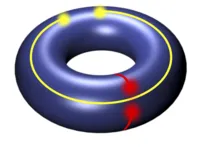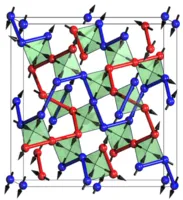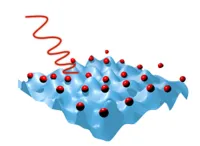Pollmann Group : Solid-State Theory
Matter occurs in various phases with different properties. For example, certain solids become magnetic when cooled to sufficiently low temperatures, and others become superconductors, i.e., they conduct electrical current without dissipation. Both of these phases are examples of collective phenomena which arise due to the interactions between many electrons in the solid. Our group is interested in systems where the interaction between the electrons yields new phases of matter. These can have very unusual and fascinating properties.
Topological Phases of matter

One focus of our research group is the investigation of topological phases which are prime examples of exotic phases with unusual properties. Topological phases are very different from conventional phases of matter. They are characterized by their low-energy excitations which are highly non- local objects that can sense each other through the medium in which they live even when they are very far apart. In our studies, we develop conceptual frameworks for classifying topological phases and we construct concrete models in order to realize them as a first step towards searching for these phases in nature. A particular focus lies on the understanding of dynamical signature of such phases. Intriguingly, such phases may be ideal building blocks of fault-tolerant quantum computers that will be able to solve difficult problems which are impossible to solve using present-day ("classical") computers.
Selected publications:
- Bosonic Integer Quantum Hall Effect in an Interacting Lattice Model, Phys. Rev. Lett. 115, 116803 (2015).
- Topological Characterization of Fractional Quantum Hall Ground States from Microscopic Hamiltonians, Phys. Rev. Lett. 110, 236801 (2013).
- Entanglement spectrum of a topological phase in one dimension, Phys. Rev. B 81, 064439 (2010).
Frustrated Systems

A fertile ground for realizing new phases of matter is the class of geometrically frustrated systems. In such systems, the geometry of the lattice prohibits a simultaneous minimization of all the inter-particle interactions, leaving some of them frustrated (hence the name). The competition between different interactions often results in multiple low-energy states with equal or nearly equal energies. We focus on the role of quantum mechanical effects in frustrated systems. For example, these can lead to emergent excitations which resemble light particles (photons) as well as to emergent particles which carry fractions of the elementary charge.
Selected publications:
- Chain-based order and quantum spin liquids in dipolar spin ice, Phys. Rev. B 92, 094418 (2015).
- Quantum Ice: A Quantum Monte Carlo Study, Phys. Rev. Lett. 108, 067204 (2012).
- Correlated fermions on a checkerboard lattice, Phys. Rev. Lett. 97, 170407 (2006).
Entanglement in quantum many-body systems

To gain deeper insights into the physics of interacting electron systems, it turns out to be helpful to borrow ideas from quantum information theory. We employ these concepts to get a more fundamental understanding of the structure of many-body quantum states that occur in the models we study. In addition, these insights allow us to design new efficient computer algorithms which are used to simulate numerically various many-particle quantum systems.
Selected publications:
- Quantum Mutual Information as a Probe for Many-Body Localization, Phys. Rev. Lett. 118, 016804 (2017).
- Unbounded Growth of Entanglement in Models of Many-Body Localization, Phys. Rev. Lett. 109, 017202 (2012).
- Theory of finite-entanglement scaling at one-dimensional quantum critical points, Phys. Rev. Lett. 102, 255701 (2009).
Quantum many-body systems out of equilibrium

When brought out of equilibrium, the interactions in a generic quantum many-body system usually lead to thermalization, i.e, local measurements appear to be thermal. This behavior can change if the systems are disordered which can then lead to so called manybody localization, preventing the system to serve as its own bath. We study the dynamics of such systems and develop an understanding of how entanglement is spreading. Further, we focus on periodically driven many-body (Floquet) systems and investigate how localization can protect dynamically generated quantum orders.
Selected publications:
- How periodic driving heats a disordered quantum spin chain, Phys. Rev. B 94, 020201(R) (2016).
- Many-Body Localization in a Disordered Quantum Ising Chain, Phys. Rev. Lett. 113, 107204 (2014).
- Dynamics after a sweep through a quantum critical point, Phys. Rev. E 81, 020101 (2010).